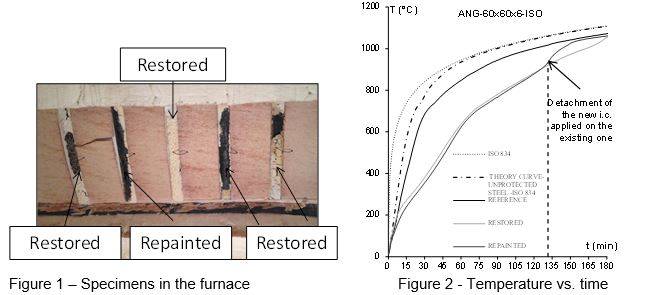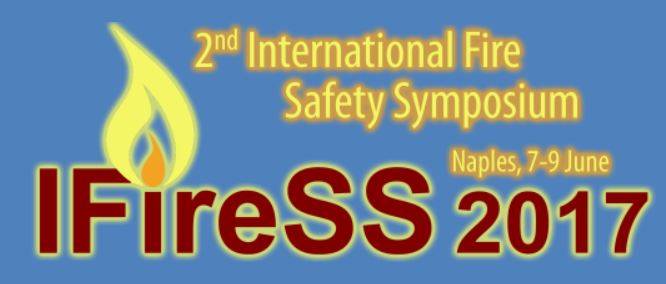Prove su vernici intumescenti per la protezione al fuoco di strutture esistenti in acciaio
Test su vernici intumescenti per la protezione dal fuoco di strutture in acciaio
Tests on intumescent paints for fire protection of existing steel structures
Articolo tratto da FireSS – International Fire Safety Symposium
Coimbra, Portugal, 20th-23rd April 2015
1. INTRODUCTION
The reduction of strength and stiffness, due to the increase of the temperature, makes steel structures vulnerable to fire. The most common fire protections (e.g. intumescent coatings, board based systems, sprayed fire protection systems and also concrete encasement or filling) reduce the heating during a fire. Intumescent coating (i.c.) are often used on exposed steel structures, since the structural, aesthetic, and architectural value of the structural objects remains preserved. Indeed, intumescent substances swell when exposed to heat and fire. When used as a paint coat or fireproofing spray, they form a protective layer on the surface. When exposed to fire or excessive heat, the protective layer will resist and absorb heat, thus protecting the structural member from damage or deformation. Volume expansion and density reduction takes place when temperature starts to rise. In order to perform rigorous and realistic analyses on protected steel members, thermal properties of all materials, including i.c., have to be known. Nevertheless, especially for existing buildings, the thermal characterization of these systems is not available and therefore experimental tests at high temperature should be performed.
Recently an experimental program was performed to characterize the fire behavior of i.c. applied on an existing 80’s steel building. The most significant results are shown to highlight the practical significance of the experimental research.
2. EXPERIMENTAL PROGRAM
The fire behavior of i.c. mainly depends on (a) thickness, (b) adhesion during normal and fire situation and (c) swelling reaction in fire situation. Therefore experimental tests concerned the measurement of the thickness and the assessment of the adhesion of the i.c. as well as fire tests in furnace.
2.1 Thickness and adhesion
The thickness measurements were performed in according with UNI EN 2808, which describes both the methods of investigation and the methods for processing data. A detailed survey of the thickness allowed to group the structural elements into homogeneous categories to simplify the assessment of the structural behavior in fire conditions. Moreover the compatibility between the layers of the protective package, (primer, coating and top coat), was assessed through adhesion tests (UNI EN ISO 4624). The average values of thickness and bond strength of the i.c. and their statistical distribution were assessed and correlated.
2.2 Test in furnace
For fire tests an horizontal furnace was used. The specimens were placed on the top opening, 3200 mm wide by 4500 mm long (see Fig.1). Previous studies showed that the dissolution of the i.c. can occur during the initial phase of the heating if the input curve is characterized by low temperature rate. Thus the tests were performed exposing the specimens to heat in the furnace according to two different time-temperature curves provided in EN 1363-1:
- Test 1 with ISO 834;
- Test 2 with Smouldering Curve (or Slow Heating Curve).
The twelve specimens in Test 1 and the ten in Test 2 are angular 850 mm long, with different sizes and thus different shape factors. Three kinds of specimens were tested:
- REFERENCE (REF) only with the existing i.c.;
- REPAINTED (REP) with a new i.c. applied on the existing i.c.;
- RESTORED (RES) with a new i.c. after removing the existing i.c..
These kinds of specimen were chosen to evaluate the behavior of the i.c. after thirty years from the application (REF specimen), the behavior of two superimposed i.c. (REP specimen) and, finally, the behavior of the new i.c. (RES specimen). Also different thicknesses were used for i.c. On each specimen several thermocouples were applied, to record the temperature during the tests.

Fig.2 shows the temperatures measured during the Test 1, on specimens 60x60x6 mm (REF,REP,RES). The temperatures of the REF specimen (namely the specimen with the existing i.c) were very close to those of the unprotected element. This indicates that the existing i.c. was not particularly effective. Moreover the RES and REP specimens have almost the same temperatures until 130 minutes, when the i.c. of the REP specimen (namely new i.c on the existing one) detaches. The effectiveness of the i.c. in Test 1 and 2 was also compared.
3. CONCLUSIONS
The experimental activity concerned the assessment of the efficiency of the existing paint and the evaluation of the degree of improvement of protection that can be achieved by applying a new intumescent paint on the steel element after removing the existing paint (restored) or simply by applying it on the existing paint (repainted). Test results showed that, after thirty years from the i.c. application, it is necessary again to protect the structural elements.
Furthermore, it was observed a correlation between the thickness of the paint and its bond strength at both normal environmental conditions and high temperatures. Indeed, elements with higher i.c. thicknesses (about 1000 ?m) showed a bond strength lower than those with thinner thicknesses. Similarly, the thickest paints detached earlier during the tests in the oven.
Finally, the results showed the possibility of reapplying the new i.c. on the old i.c., with considerable economic advantages, if good bond of the existing substrate is guaranteed.
SCARICA LA VERSIONE INTEGRALE
 IFireSS 2017 - 2nd International Fire Safety Symposium 2017
IFireSS 2017 - 2nd International Fire Safety Symposium 2017
Il 2nd International Fire Safety Symposium 2017 (IFireSS 2017) si terrà presso l’Università di Napoli Federico II nei giorni 7-9 Giugno 2017, nelle sale del Centro Congressi Federico II sito in via Parthenope a Napoli.
Il Symposium è organizzato dal Di.St. - Dipartimento di Strutture per l’Ingegneria e l’Architettura dell’Università di Napoli Federico II e dal CIB (International Council for Research and Innovation in Building and Construction) e rappresenta la seconda edizione dell’”International Fire Safety Symposium”, la cui prima edizione si è tenuta a Coimbra (Portogallo) nel 2015.
Il Symposium ha l’obiettivo di contribuire allo scambio di idee e conoscenze tra gli esperti internazionali e nazionali del settore della Sicurezza Antincendio e di raccogliere e divulgare i risultati più avanzati della ricerca scientifica, delle esperienze tecnico-professionali e dell’industria, delle attività normative e dei Vigili del Fuoco sul tema della Ingegneria della Sicurezza Antincendio.
Pitture e Vernici
Guida tecnica alle pitture edilizie: tipologie, prestazioni, tecniche applicative e problemi ricorrenti. Un punto di riferimento per progettisti e applicatori.


